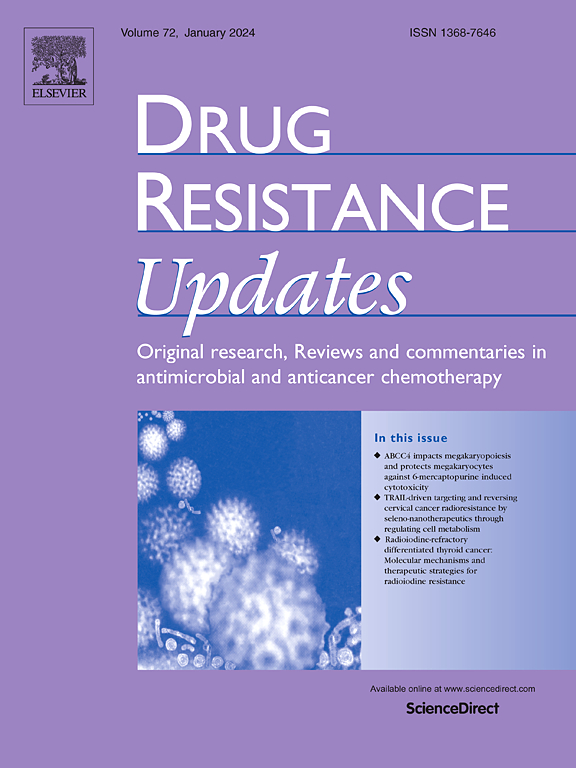Drug resistance in breast cancer: Mechanisms and strategies for management
IF 21.7
1区 医学
Q1 PHARMACOLOGY & PHARMACY
引用次数: 0
Abstract
Therapeutic resistance remains a significant challenge in breast cancer treatment, often driven by factors such as genetic mutations, dysregulation of receptors and signaling pathways, alterations in drug metabolism and transport, cellular heterogeneity, and modifications in the tumor microenvironment. As a highly heterogeneous and complex disease, breast cancer exhibits distinct molecular and histopathological characteristics, necessitating tailored therapeutic approaches. This article reviews recent advancements in understanding therapy resistance across four major subtypes — Luminal A, Luminal B, HER2-enriched, and triple-negative breast cancer (TNBC) — and explores potential strategies to overcome resistance, providing insights into developing novel therapeutic interventions. Notably, TNBC patients have limited treatment options, with chemotherapy remaining the standard approach and immunotherapy emerging as an adjunct strategy. We concisely overview key mechanisms contributing to therapy resistance and discuss innovative therapeutic strategies, including combination regimens, molecularly targeted therapies, photodynamic therapy, and ferroptosis-inducing treatments. Additionally, we highlight recent advancements in multi-omics data integration and artificial intelligence-driven approaches in breast cancer research. Future efforts should focus on refining predictive models, optimizing combination therapies, and leveraging artificial intelligence to enhance treatment efficacy, ultimately overcoming resistance and improving long-term outcomes for breast cancer patients.
乳腺癌的耐药:机制和管理策略
治疗耐药仍然是乳腺癌治疗中的一个重大挑战,通常由基因突变、受体和信号通路失调、药物代谢和转运改变、细胞异质性和肿瘤微环境改变等因素驱动。作为一种高度异质性和复杂性的疾病,乳腺癌表现出独特的分子和组织病理学特征,需要量身定制的治疗方法。本文回顾了四种主要亚型(Luminal A, Luminal B, her2富集和三阴性乳腺癌(TNBC))治疗耐药的最新进展,并探讨了克服耐药的潜在策略,为开发新的治疗干预措施提供了见解。值得注意的是,TNBC患者的治疗选择有限,化疗仍然是标准方法,免疫治疗作为辅助策略出现。我们简要概述了治疗耐药的关键机制,并讨论了创新的治疗策略,包括联合治疗方案、分子靶向治疗、光动力治疗和诱导铁中毒治疗。此外,我们还重点介绍了乳腺癌研究中多组学数据集成和人工智能驱动方法的最新进展。未来的工作应该集中在完善预测模型,优化联合治疗,利用人工智能来提高治疗效果,最终克服耐药,改善乳腺癌患者的长期预后。
本文章由计算机程序翻译,如有差异,请以英文原文为准。
求助全文
约1分钟内获得全文
求助全文
来源期刊

Drug Resistance Updates
医学-药学
CiteScore
26.20
自引率
11.90%
发文量
32
审稿时长
29 days
期刊介绍:
Drug Resistance Updates serves as a platform for publishing original research, commentary, and expert reviews on significant advancements in drug resistance related to infectious diseases and cancer. It encompasses diverse disciplines such as molecular biology, biochemistry, cell biology, pharmacology, microbiology, preclinical therapeutics, oncology, and clinical medicine. The journal addresses both basic research and clinical aspects of drug resistance, providing insights into novel drugs and strategies to overcome resistance. Original research articles are welcomed, and review articles are authored by leaders in the field by invitation.
Articles are written by leaders in the field, in response to an invitation from the Editors, and are peer-reviewed prior to publication. Articles are clear, readable, and up-to-date, suitable for a multidisciplinary readership and include schematic diagrams and other illustrations conveying the major points of the article. The goal is to highlight recent areas of growth and put them in perspective.
*Expert reviews in clinical and basic drug resistance research in oncology and infectious disease
*Describes emerging technologies and therapies, particularly those that overcome drug resistance
*Emphasises common themes in microbial and cancer research
 求助内容:
求助内容: 应助结果提醒方式:
应助结果提醒方式:


